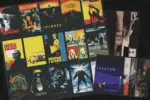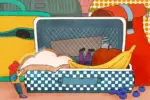When I was nine years old, I wrote an anthology of thirty-two poems on cardstock paper that I found beneath the printer. Rifling through the pages today, I read about toys on adventures, cities in the clouds, springtime, honey, and the sea, the sea, the sea. Four poems I spent describing the water, the briny air, and the roughness of shells in sand. The paper is pulpy and thin where I erased until I had found the right phrases. The words, penciled in so thoughtfully, speak of soft moments and of starlight cradled in the crests of waves. With a child’s earnestness I wrote simply and freely, about free and simple things. Though not the most refined or skillful, it is the most wonderful poetry I have ever read.
I read from these pages with a love that almost aches. The past envelopes me, so very gently. I am climbing the tree in my backyard again, ignoring the sting of oak bark on my palms, pretending I captain a pirate ship. I am frightened of bees but watch, with such reverence, as honey refracts sunlight onto the dining table. I am sitting in the shade of a royal poinciana with a grape popsicle to escape the blistering summer heat. I grow bored and cannonball my way back into the pool. I am whispering to my teddy bear under the sheets because I am about to turn double digits in the morning and she is my best friend in the entire world. I am learning what it means to be alive.
An evening ten years ago comes to mind as I shuffle the yellowed pages. Low tide at an empty beach on the Gulf of Mexico, I traced patterns into the wet sandbar. This beach was special — as I traced deeper, tan sand gave way to gray gave way to mauve. The occasional hermit crab would meander across my designs. They left tiny footprints, so delicate the tracks were barely visible. Unknowingly the crabs became my most treasured collaborators. Waning sunlight caught in the droplets of seawater on their shells, putting little suns on their little backs. I mourned as the tide came in and our drawings returned to the water, and wrote in the sand a couplet, unrhyming. It was about footprints and waves and impermanence and solitude. I walked home in the burgeoning night to put the words onto paper before they slipped away. I hold that paper in my hand now and pretend I can still smell the salt.
At nineteen, poetry is no longer peaceful, and it has not been for some time. I do not aspire to the likes of Frost and Stevenson, finding my inspiration instead in Confessional poets — Plath and Sexton, who speak in a language I better understand. The act of writing has become an act of violence, a dissection of the uncomfortable and an interrogation of my own desires. I painstakingly dismantle my own beliefs and render them ink. Writing poetry is both the same as and radically different from what it was a decade ago, and it boils down to something simple. I have always written what is true, but what is true is no longer beautiful. The gentleness is gone, and I do not write about hermit crabs anymore.
For years I struggled to restore that gentleness, but found other arts like theater, choir, and piano to be paltry substitutes for childhood poetry. On the stage I was an artificial girl. I recited lines and read sheet music and felt nothing of note, grasping at straws for years. It was not until recently that I eyed my painting supplies with tentative curiosity more than perfunctory indifference. Of these supplies that were used solely for school, I asked, can you fix this? By which, of course, I meant: please take me back, I’m not ready to grow up yet. I was a tired teenager afraid of becoming a tired adult, well aware that painting could not stop time and asking anyways. While it, indeed, did not stop time, it has since allowed me to restore something of a childlike wonder to my life. To see the world through a painter’s eyes is akin to seeing it anew, I have discovered.
Now, my painting exclusively takes the form of still lifes, composed entirely of household items. They are plain and unremarkable, arrangements consisting of kitchen utensils and the odd colorful fruit. That is my intent. I do this because on the countertop, the tea kettle is blue. On my canvas, the tea kettle is cobalt, cerulean, and ultramarine, with shadows in phthalo blue and highlights in titanium white. A red rose is alizarin crimson and Indian red, but never cadmium red because cadmium is warm and the rose is cool in my hand. I create three different colors to paint the mango because its skin tells me it is halfway to ripe but I am impatient and open it anyways. Reality fractures into something more strange and beautiful under the careful ministrations of my palette knife. I mix the paints and nothing is ordinary. I mix the paints and think maybe this can be enough.
The allure of painting does not stop at my exploration of color, as the brushstrokes hold their own unique import, too. Each time I touch brush to canvas, I do so with deliberation and forethought. I do nothing to the canvas carelessly, taking the time to relish the subtle scrape of bristle on cloth and the smooth glide of layering paint on paint. The act of noticing these things keeps my mind calm — not empty, per se, but so singularly focused that everything else is temporarily insignificant. My world narrows; I have built myself a sanctuary, of sorts, and active observation is my religion. There is peace to be found in the acknowledgement of quiet things, and an even greater peace in the creation of quiet things: I take charge of my own peace at the painting table. I have tired of waiting for it to fall into my lap.
Despite my best efforts, time continues to pass. I am nearly twenty, and I am growing up, and I will paint until I am a child again, afraid of bees but not of growing up. With a lifelong earnestness I continue painting simply and freely, about free and simple things.
















